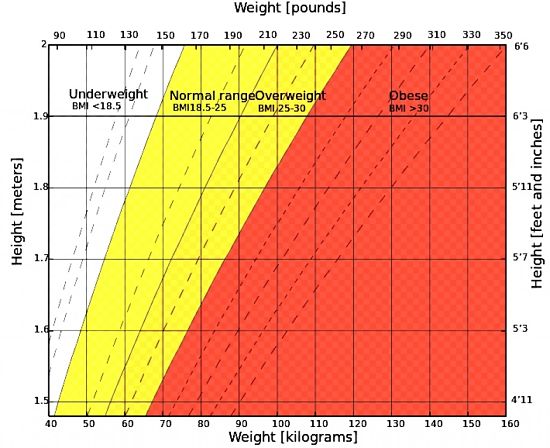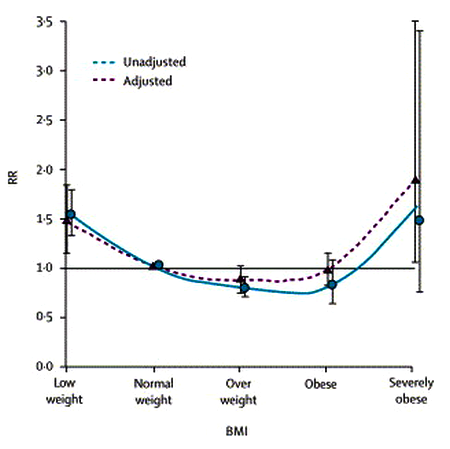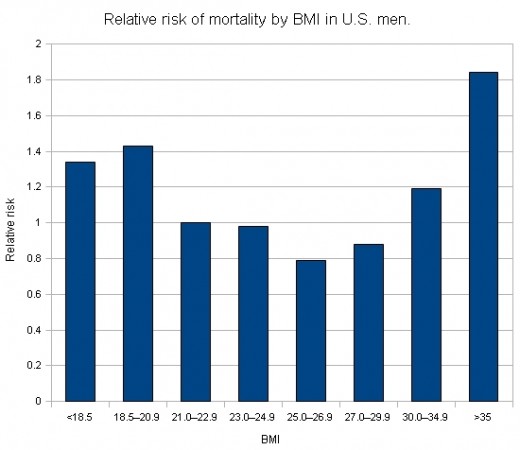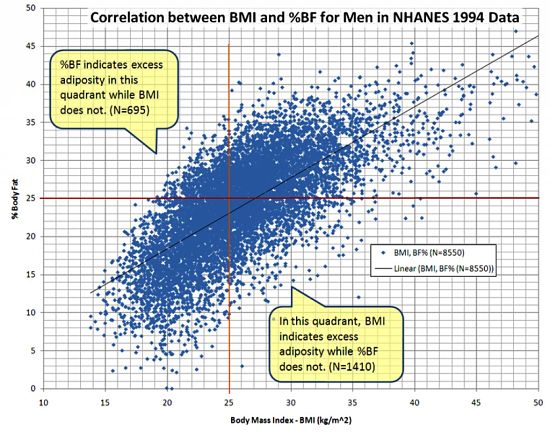Why BMI is Not a Good Predictor of Cardiovascular Mortality Risk
A recent study has created a lot of controversy because it found that people whose weight and height placed them in the "overweight" BMI category ( BMI 25 - 30) were 6% less at risk of dying than those in the "normal" BMI category (BMI 18.5 - 25).
The BMI is the Body Mass Index which is the body weight (kilograms) divided by the square of the height (meters squared; kg/ m x m). The study results were interpreted as suggesting that putting on a few extra pounds or kilos may acually be beneficial.
The study appeared to conclude that people who are overweight or slightly obese appeared to live longer than those with more 'healthy' weights and with normal BMI's.
The study was a very large one and examined around 270,000 deaths amongst nearly 3 million adults. The study compiled the results from 100 previous studies are around the world.
Many established researcher have claimed the conclusions from this study were 'rubbish' and have criticized the methodology and conclusions as misleading and harmful. They highlighted that countless other studies and huge amounts of data that show go the opposite.
The cause of this 'false' conclusion may be the BMI measure itself, which has been shown to be a generally unreliable predictor of heart disease and premature mortality.
This article reviews research on the BMI and examines other measures of weight and mortality risks that may be more appropriate.

What are The BMI Categories
The general BMI categories are shown in the figure above and the table below.
|
Category
|
BMI range - kg/m2
|
|---|---|
|
Very severely underweight
|
less than 15
|
|
Severely underweight
|
from 15.0 to 16.0
|
|
Underweight
|
from 16.0 to 18.5
|
|
Normal (healthy weight)
|
from 18.5 to 25
|
|
Overweight
|
from 25 to 30
|
|
Obese Class I (Moderately obese)
|
from 30 to 35
|
|
Obese Class II (Severely obese)
|
from 35 to 40
|
|
Obese Class III (Very severely obese)
|
over 40
|
|
BMI Category
|
BMI
|
Hazards Ratio Compared with Normal BMI
|
Differences in Risk of Mortality
|
|---|---|---|---|
|
Normal
|
BMI 18.5 -25
|
1
|
|
|
Overweight
|
BMI 25-30
|
0.94
|
6% Lower
|
|
Grade 1 obesity
|
BMI 30-35
|
0.95
|
5% Lower
|
|
Grade 2 and 3 Obesity
|
BMI >35
|
1.29
|
30% Higher
|
BMI and Risk of Death from Heart Disease and Other Causes
The results of the major study discussed above are summarised in the table opposite. The mortality risk for the overweight and obese categories was compared using the ratio of the risk compared with people having a BMI in the normal range. The study suggested that the mortality risk was 5-6% LOWER for the overweight and moderately obese (Grade 1) categories than for people of normal BMI. The mortality for the extreme BMI categories was 30% HIGHER.
The image below shows that other large scale studies have shown little difference in mortality for the middle BMI categories.

Common 'U' Shaped Relationship between BMI and Risk of Mortality
The image below shows the typical relationship for most previous studies which has been used by health authorities throughout the world for campaigns against the obesity epidemic.


Relationship between BMI, Body Fat Percentage and Waist Circumference
As shown in the figure above, BMI shows only a weak relationship with body fat.
For any given BMI value there is a huge spread of body fat value.
Some researchers have claimed that percent body fat is a better predictor of the risk of heart disease and premature death than BMI.
Also, BMI may be a poor predictor of activity level or fitness. Many active people fall into the 'overweight category', but some of them are very fit and even run marathons. Being overweight (high BMI) does not imply that people are in bad shape.
The positive effects of regular exercise and keeping in shape may outweigh the negative effects of obesity. Many weight builders may be classified as overweight and obese, despite having little fat on their bodies.
BMI is a very simple predictor of weight, but is not a good measure of muscle mass, or fat percentage, nor of overall fitness all of which which contribute to the risk of heart disease and early death.
Oddly, because people are classified as overweight or obese, may bias the results of the study between BMI and mortality risk. People in the 'Normal' and 'Minor Overweight' BMI groups may be less likely to seek medical diagnosis and be on medications to control high blood pressure and cholesterol levels. The people in the 'normal' BMI group may therefore be the 'sleepers', and may be more at risk, because any of the problems they have may remain undiagnosed and not treated or controlled.
There is extensive research that shows that the distribution of fat on the body has a profound effect on mortality risks.
Fat accumulation around the waist has been shown to pose a greater risk for cardiovascular disease than BMI itself.
Fat accumulation in the lower body and legs is less of a problem. But the crude BMI does not distinguish between where on the body fat has accumulated.
Two ways of measuring fat distribution as an index are 'waist circumference' and 'waist-to-hip' ratio.
Several major studies have demonstrated that 'Abdominal Obesity' (belly fat, central obesity, fat around the stomach and abdomen) is a stronger risk factor measure than BMI.
A new obesity measurement tool has been suggested called the Body Shape Index (ABSI) that combines waist circumference and BMI. It has a rather complicated formula
Body Shape Index= Waist Circumference/[(BMI 2/3)*(height1/2)]
While BMI measures body size or simple ‘bigness’, the ABSI measures the 'roundness' of the body.
The ABSI compares the actual waist circumference with that expected from the weight and height (BMI).
High ABSI may successfully identify people who have unhealthy body shapes (belly fat), despite having waist circumference and weight within the normal range.
It may therefore identify people who may benefit from diet and lifestyle changes, such as increase exercise and activity, despite being in one of the 'safer' BMI categories.
Conclusion
BMI has been shown to be a poor predictor of the risk of heart disease and mortality for the 'overweight' and moderately obese categories and should be combined with body shape indicators such as waist circumference or waist-to-hip ratio. Measures of activity levels and fitness are also important.